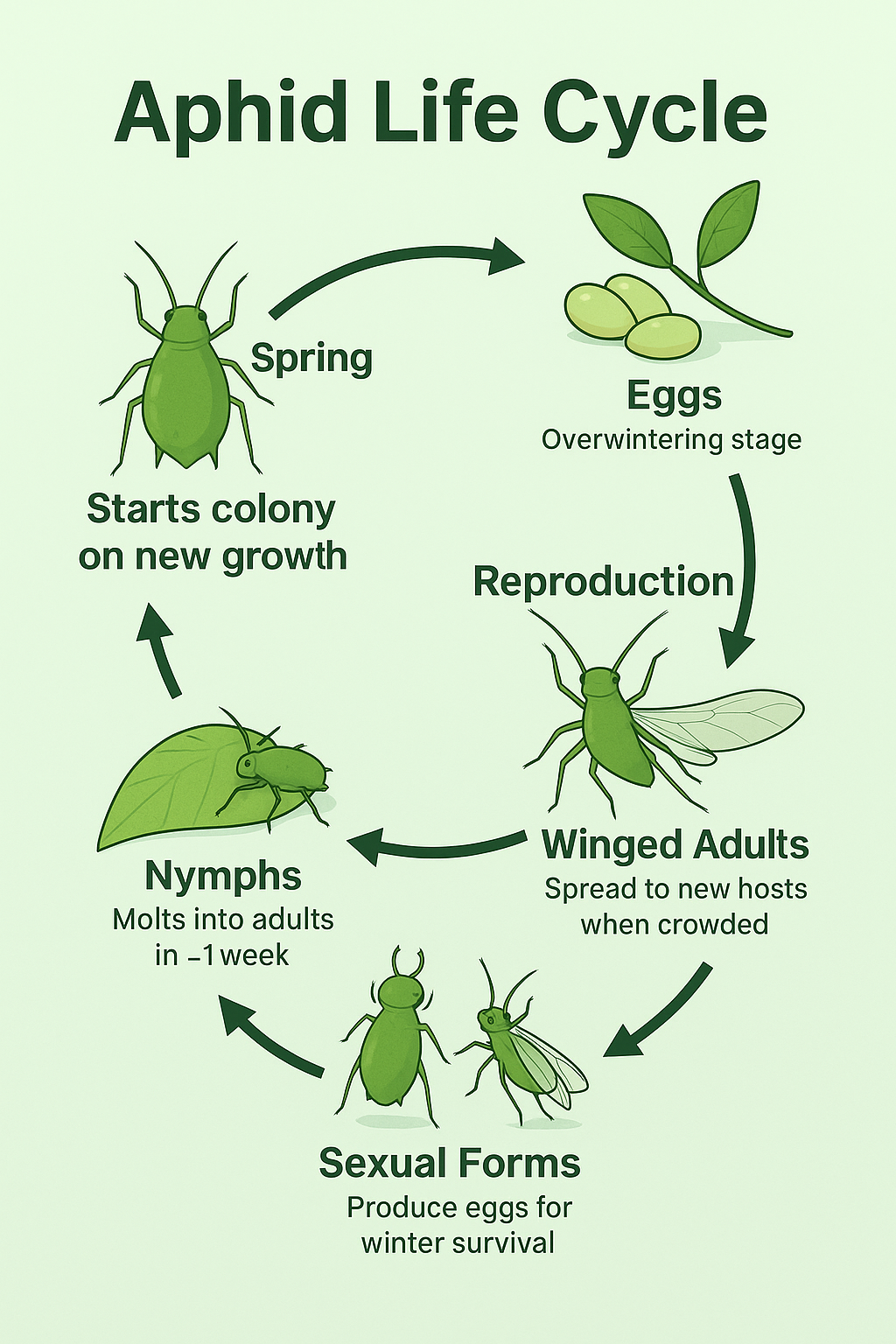Introduction
Aphids are among the most common and destructive pests for both home gardeners and commercial growers. These tiny insects may look harmless, but their rapid reproduction and feeding habits can quickly overwhelm plants. Left unchecked, they not only damage leaves and stems but also spread plant viruses, making them a top concern for anyone serious about healthy, thriving crops.
What Are Aphids?
Aphids are small, soft-bodied insects belonging to the superfamily Aphidoidea within the order Hemiptera. They are typically pear-shaped and range in color from green, black, and brown to red and yellow. Measuring just 1–4 mm, they often go unnoticed until their populations explode.
Aphids feed by inserting their piercing-sucking mouthparts into plant tissue, extracting sap. This weakens plants, causes distorted growth, and, in severe cases, can lead to plant death.
Common Species of Aphids
While there are over 4,000 species worldwide, a few are especially notorious in horticulture and agriculture:
-
Green Peach Aphid (Myzus persicae) → Infests a wide range of vegetables and ornamentals; a major virus vector.
-
Cotton Aphid (Aphis gossypii) → Affects cucurbits, chrysanthemums, peppers, and more.
-
Potato Aphid (Macrosiphum euphorbiae) → Common on solanaceous plants and ornamentals.
-
Cannabis Aphid (Phorodon cannabis) → An emerging issue for cannabis growers, often hidden on stems and leaf undersides.
Learn more about Root Aphids in our dedicated pest profile.
Why Are Aphids a Problem?
Aphids damage plants in several ways:
-
Sap feeding → Stunts growth, curls leaves, and weakens plants.
-
Honeydew secretion → Creates sticky surfaces, attracting ants and leading to sooty mold growth.
-
Virus transmission → Capable of spreading dozens of plant viruses within minutes of feeding.
Symptoms include:
-
Yellowing, curling, or distorted leaves.
-
Stunted plant growth.
-
Sticky residue on leaves and surfaces.
-
Black fungal growth (sooty mold).
-
Ants “farming” aphid colonies for honeydew.
Aphid Life Cycle
One reason aphids are so difficult to manage is their rapid reproductive cycle:
-
Females often reproduce without mating (parthenogenesis).
-
A single aphid can give birth to 60–100 live young in a few weeks.
-
Winged forms appear when colonies grow crowded, allowing them to spread to new plants.
-
Indoors or in greenhouses, aphids can reproduce year-round.

Biological Control of Aphids
Biological control is the most sustainable way to manage aphids long-term. Releasing natural enemies allows nature to do the work for you.
Green Lacewing (Chrysoperla carnea)
Nicknamed the “aphid lion,” lacewing larvae are voracious predators, consuming hundreds of aphids in their short life stage. Shop Lacewings
Parasitic Wasps (Aphidius colemani & A. ervi)
Tiny but powerful, these wasps lay eggs inside aphids, turning them into “aphid mummies.” Ideal for greenhouse and indoor crops. Shop Aphidius
Predatory Midges (Aphidoletes aphidimyza)
Excellent for large outbreaks, these midges actively hunt aphids in greenhouses. Shop Aphidend
Lady Beetles (Adalia bipunctata)
Both adults and larvae feed on aphids. They’re especially effective in outdoor releases. Shop Adalia
Implementing Biological Control in Plants
To successfully implement biological control for aphids in plants, follow these practical tips:
- Identify the Target Problems: Accurate identification of the aphid species present in your plants is essential for selecting the appropriate biological control agents. Regular monitoring and scouting can help detect infestations early.
- Choose the Right Beneficial Insects: Select beneficial insects that are specific to the aphid species and suited to the indoor environment. Consider factors such as temperature, humidity, and the presence of other beneficial organisms.
- Release Beneficial Insects at the Right Time: Timing is crucial for the effectiveness of biological control. Release beneficial insects when aphid populations are low to moderate, allowing them to establish and reproduce before problem numbers become overwhelming.
- Provide Suitable Habitats: Create a conducive environment for beneficial insects by providing suitable habitats, such as flowering plants that offer nectar and pollen. Avoid the use of broad-spectrum pesticides that can harm beneficial insects.
- Monitor and Evaluate: Regularly monitor aphid and beneficial insect populations to assess the effectiveness of the biological control program. Adjust release rates and strategies as needed to maintain effective problem management.
Additional Natural Methods for Aphid Control
In addition to biological control, several other natural methods can help manage aphid infestations in plants:
- Neem Oil: Neem oil is a natural insecticide derived from the neem tree. It can be effective in controlling aphids by disrupting their feeding and reproductive processes. Apply neem oil as a foliar spray, ensuring thorough coverage of the infested areas.
- Insecticidal Soap: Insecticidal soap is a contact insecticide that can help control aphids by breaking down their protective coating. Apply insecticidal soap directly to the aphids, ensuring thorough coverage.
- Rubbing Alcohol: Dabbing aphids with a cotton swab soaked in rubbing alcohol can help kill them on contact. This method is particularly useful for small infestations and can be combined with other control methods for greater effectiveness.
- Pruning and Disposal: For heavily infested plants, pruning and disposing of affected plant parts can help reduce aphid populations. Be sure to dispose of the pruned material properly to prevent the spread of aphids to other plants.
FAQs
Q: Will beneficial insects fly away indoors?
A: Some will, but many (like lacewing larvae and Aphidius wasps) remain on plants until food is scarce.
Q: How long until I see results?
A: Typically within 7–14 days, depending on environmental conditions.
Q: Can I combine different beneficial insects?
A: Yes — in fact, using multiple species (e.g., lacewings + Aphidius) improves coverage.
Conclusion
Aphids are a universal pest, but they don’t have to be a persistent problem. By understanding their life cycle and applying a mix of cultural, mechanical, and biological strategies, you can keep populations in check — naturally and sustainably.
Ready to let nature take the lead? Explore our full range of Beneficial Insects for aphid control.
Learn More:
Lions, Tigers, and Bugs, Oh My! - Natural Enemies


